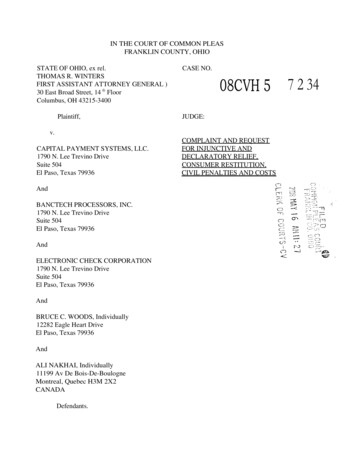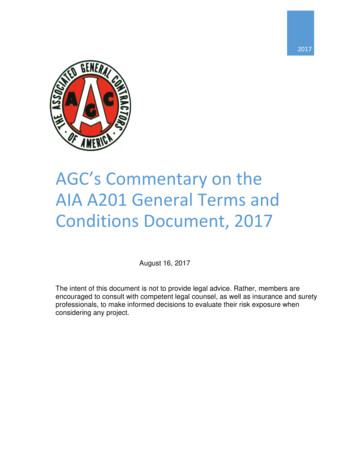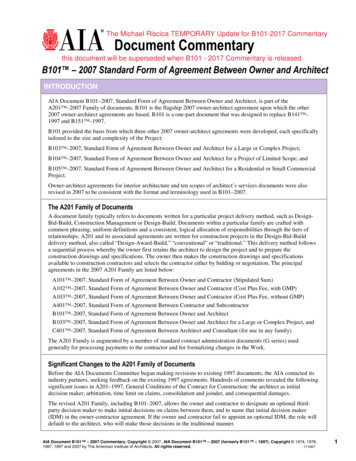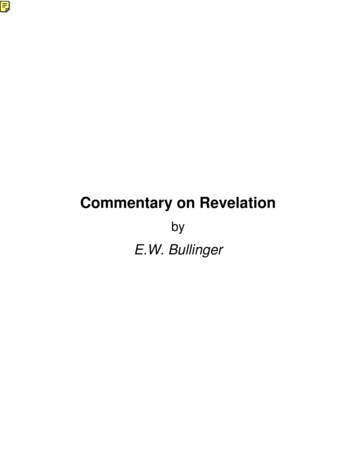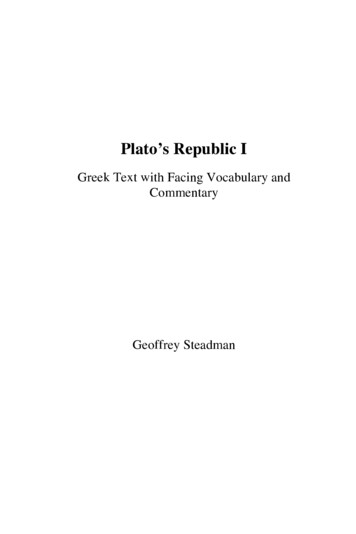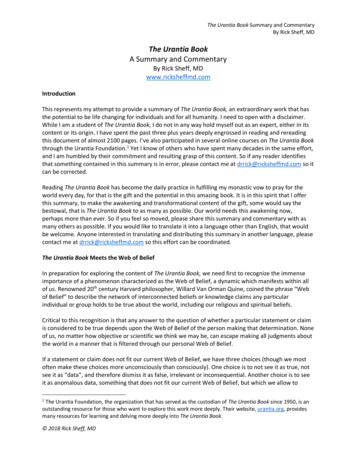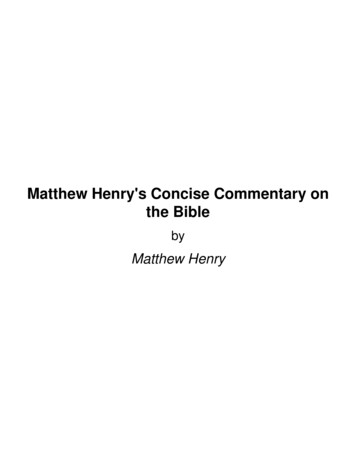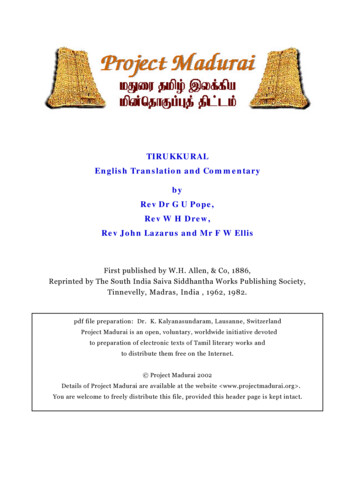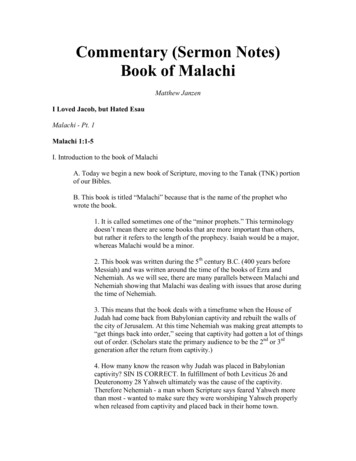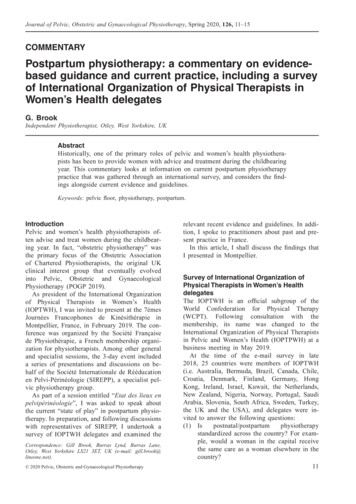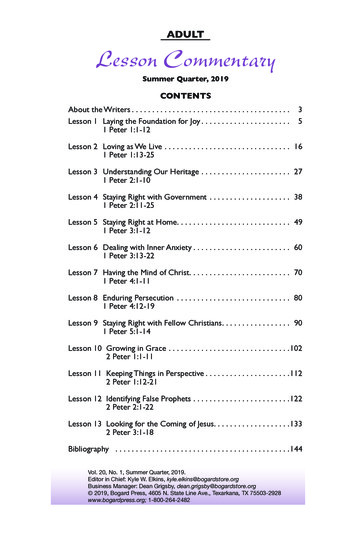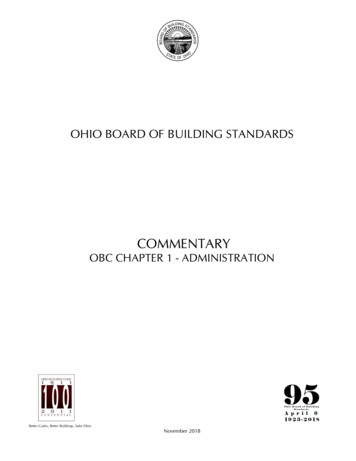
Transcription
OHIO BOARD OF BUILDING STANDARDSCOMMENTARYOBC CHAPTER 1 - ADMINISTRATIONBetter Codes, Better Buildings, Safer OhioNovember 2018
OBC CHAPTER ONE CODE COMMENTARY - 2
TABLE OF CONTENTSINTRODUCTION. 4KEY . 4BBS CODE ADOPTION HISTORY . 5OBC KEY WORDS . 6SECTION 101 General . 9SECTION 102 Applicability and Jurisdictional Authority . 19SECTION 103 Certifications – Moved to OAC 4101:7 . 27SECTION 104 Duties & Responsibilities . 28SECTION 105 Approvals . 34SECTION 106 Construction Documents. 38SECTION 107 Plan Approval Process. 46SECTION 108 Inspection Process . 51SECTION 109 Orders and Violations . 57SECTION 110 Appeals . 59SECTION 111 Certificate of Occupancy, Certificate of Completion . 60SECTION 112 Changes to the Code . 64SECTION 113 Industrialized Units . 65SECTION 114 Products and Materials . 68SECTION 115 Board Committees . 72OBC CHAPTER ONE CODE COMMENTARY - 3
COMMENTARYOBC CHAPTER 1 - ADMINISTRATIONINTRODUCTION:In 1973, the Ohio Building Officials Association (OBOA) requested the Board of Building Standards to adopt anational model code in place of the Ohio Building Code (OBC). The OBC had originally been developed bythe Board in conjunction with several professors at Case Western University and the University of Akron in the1950's. OBOA made this request because the Board had not continued to update the building code since1971. After receiving the request, the Board decided that it would explore having the Building ConstructionLaboratory at Ohio State University update the existing code.In 1976, there was a change in administrations. OBOA again requested the Board to adopt one of the nationalmodel building codes. The Board instructed staff to compare the ICBO uniform code, the BOCA national code,and the SBCCI southern standard code. In 1977, the Board held a series of open hearings (hearings open to thepublic, but not mandated by the Ohio Administrative Procedures Act) to get input from the buildingconstruction industry and from the code enforcement agencies. In 1978, the Board decided to use the BOCANational Building and Mechanical Model Codes. Staff changed those sections of the basic model codes thatconflicted with the Ohio Revised Code (statutory law) to bring it into compliance with the General Assembly’slegislation. Rule filings were then done in accordance with Sections 119.03 and 119.04, Ohio Revised Code,and a public hearing was held. After public hearing, the Board adopted the Ohio Basic Building Codes, basedupon the BOCA model codes, on September 29, 1978. The Board set an effective date of July 1, 1979, for theOBBC.The July 1, 1979, effective date was set to allow the building construction industry, design professionals, andenforcement agencies to familiarize and educate themselves concerning the code. The Board also made severalmajor changes to the original adoption in May and June, 1979, as a result of industry input. The enforcementagency at the state level (Ohio has a dual enforcement system; i.e., local governments have the option of beingcertified to enforce the state code and, if they don’t, a state agency does the enforcement) allowed plans to besubmitted between July 1, 1979, and September 30, 1979, under either OBC (the outgoing code) or underOBBC, the new code. This allowed for a smooth transition.Since that time the Ohio Board of Building Standards has adopted building code requirements based uponBOCA and ICC model code documents that were modified to be consistent with Ohio law. The adoptionhistory for the codes is shown in the table below.KEY:The code text of Chapter One is shown in bold text and the commentary text is usually located below the code text and isitalicized and boxed as shown below:101.2 Scope. The provisions of theOhio Building Code shall apply tothe Code TextThis provision requiresone copy of the approvedconstruction documents to Commentary TextOBC CHAPTER ONE CODE COMMENTARY - 4
CODE ADOPTION HISTORY:BBS CODE ADOPTION HISTORYEffective Date:1 July 19791 January 19811 July 19821 March 19851 March 1986January 19891 September 19921 July 19951 March 19981 January 20021 March 20051 July 20071 November 20111 November 2017CodeOBBC & OMC Based nicalPlumbingBuildingMechanicalPlumbing1978 BOCA - 7th Edition1978 BOCA - 3rd Edition1980 BOCA1981 BOCA - 8th Edition and 1982 Supplement1981 BOCA - 4th Edition and 1982 Supplement1984 BOCA - 9th Edition1984 - 5th Edition1985 BOCA1987 BOCA - 10th Edition1987BOCA - 6th Edition1990 BOCA - 11th Edition1990 BOCA - 7th Edition1993 BOCA -12th Edition1993 BOCA - 8th Edition1996 BOCA - 13th Edition1996 IMC - 1st Edition1995 IPC - 1st Printing2000 IBC – 1st Edition and March 2001 Supplement and ICC Errata2000 IMC – 1st Edition and March 2001 Supplement and ICC Errata2000 IPC – 1st Edition and March 2001 Supplement and ICC Errata2003 IBC – 1st Printing and ICC Errata2003 IMC – 2nd Printing and ICC Errata2003 IPC – 2nd Printing and ICC Errata2006 IBC – 1st Printing and ICC Errata2006 IMC – 1st Printing and ICC Errata2006 IPC – 1st Printing and ICC Errata2009 IBC – 1st Printing and ICC Errata2009 IMC – 1st Printing and ICC Errata2009 IPC – 1st Printing and ICC Errata2012 and 2015 IBC – 1st Printing and ICC Errata2012 and 2015 IMC – 1st Printing and ICC Errata2012 and 2015 IPC – 1st Printing and ICC ErrataDuring the years of work on building department and personnel certification, education and training,and code development, any guidance on the intent of the “Ohio-ized” provisions board had neverexisted. This document is intended to take steps in filling that void.As a commentary on the administrative chapter of the Ohio Building Code, the Board of BuildingStandards and Board staff has attempted to put together, in one place, information that will assist theenforcement and user communities in improving their understanding of the intent of the provision ofthe Ohio requirements. Future work will expand this document into those other areas of the codeswhere, because changes to the model code language have been needed in Ohio, the intent cannot belearned from the model code commentary documents.Concurrent with the update of the Ohio codes, the Board has modified the administrative chapter tomore clearly communicate the duties and responsibilities of certified entities as well as inform codeusers of the intent of the code and its enforcement procedures. This was done to make the code easierfor users to navigate, to make it easier for users to understand the code enforcement procedures, andto explain the duties and responsibilities of all the participants in the code compliance process.OBC CHAPTER ONE CODE COMMENTARY - 5
OBC KEY WORDS:It is our hope and intent that this information - one aspect of the Board’s work to fulfill its responsibilities inlaw as described in Section 101.3 below - will be useful to the code user. These words and their definitionsare a critical part of developing an understanding of the purpose, intent, and philosophy of codeenforcement in Ohio.Agricultural building. A structure designed and constructed to house farm implements, hay, grain, poultry, livestockor other horticultural products. This structure shall not be a place of human habitation or a place of employmentwhere agricultural products are processed, treated or packaged, nor shall it be a place used by the public (see“agricultural purposes,” section 101.2, and section 312 of this code).Agricultural purposes: Includes agriculture, farming, dairying, pasturage, apiculture, horticulture, floriculture,viticulture, ornamental horticulture, olericulture, pomiculture, animal and poultry husbandry, etc.The previous two definitions assist in determining those structures, along with one-, two-, or three-family dwellings thatare exempted from the jurisdiction of the OBC pursuant to ORC 3781.06. Refer to 101.2 below.Apiculture – beekeeping; Viticulture – grape-growing; Floriculture – flower-growing; Olericulture – vegetable-growing;Pomiculture – fruit-growingBuilding official: The superintendent of the division of industrial compliance of the Ohio department of commerce orthe person appointed by the superintendent to enforce the OBC in that division, or the designated authority chargedwith the administration and enforcement of this code, approved by the Board of Building Standards in accordancewith section 103 of the OBC, in a municipal corporation, township or county having a building department, certifiedby the board of building standards pursuant to section 3781.10 of the revised code, or the health commissioner or hisauthorized representative in health districts, whichever one has jurisdiction.In certified municipal building departments, it is relatively easy to determine the identity of the building official. Incertified township or county building departments, however, there is an unusual complication that must be understoodbecause of its impact on the issuance of plan approvals, inspections, and certificates of occupancy.While certified municipal building departments have the right to employ plumbing inspectors, certified township andcounty building departments do not. Plumbing plan review, approval, and inspections are the jurisdiction of thecounty health district. The plumbing inspector employed by the county or city Board of health has exclusivejurisdiction to enforce the provisions of the plumbing code. Unlike plan review under the building and mechanicalparts of the building code, the plumbing inspector of the county Board of health does plan review as well asinspections. Appeals of any orders are heard solely by the Ohio Board of Building Appeals pursuant to Sections3781.031 and 3781.19, Revised Code.There are 156 plumbing inspectors employed by 81 certified municipal building departments and 87 plumbinginspectors employed by 39 health districts in Ohio.Building service equipment: Equipment, materials, devices, and systems integrated into a building which provide airconditioning, fire protection, lighting, electricity, sanitation, water, space heating, ventilation and other media such asgases and fluids for use within a building. Processing equipment is not part of the building service equipment.Building service equipment begins from the utility supply/connection point through point of use but does not includeprocessing equipment.Building services piping. All piping systems and their component parts that are part of a building system and thatpromote the safe, sanitary, and energy efficient occupancy of a building. Building services piping includes, but is notlimited to, cold and hot potable water distribution for plumbing fixtures; sanitary lines from plumbing fixtures;nonflammable medical gas systems; medical oxygen systems; medical vacuum systems; fire protection piping systemsand compressed air in dry systems; refrigeration, chilled water, condenser and cooling tower water, brine, andwater/antifreeze systems; steam, steam condensate, and hot water piping systems; and fuel oil piping and fuel gaspiping for heating, cooling, and cooking applications.The construction codes in Ohio were authorized to protect public health and safety by establishing standards forbuildings. This can only be accomplished by assessing the risks inherent in the type of construction, how the buildingis to be occupied, and its size. To manage these risks, the codes establish levels of safety for these risk factors and putin place building equipment and systems to manage the associated risks. These systems and equipment include all thesystems integrated into the building such as air conditioning, fire protection, lighting, electrical distribution, sanitation,transportation, egress, water supply, space heating, ventilation, and other systems for use within a buildingBecause of the interrelation of these systems in managing risks, no one system should be seen as independent of theothers. The ascertainment of compliance with the codes by the building department of the design, approval,installation, inspection, and testing of these systems is an important part of code enforcement. A proper understandingOBC CHAPTER ONE CODE COMMENTARY - 6
of the terms Building Service Equipment and Building Services Piping will provide a clear understanding of the extentof the jurisdiction of the building, mechanical, and plumbing codes.Construction documents: Written, graphic and pictorial documents prepared or assembled for describing the design,location and physical characteristics of the elements of a project necessary for obtaining plan approval in accordancewith section 106.Dwelling: A structure consisting exclusively of three or fewer dwelling units, with or without garages or accessoryspaces, used, intended, or designed to be used, for living purposes.Fire prevention: The preventative measures which provide for the safe conduct and operation of hazardous processes,storage of combustible and flammable materials, conducting of fire drills and the maintenance of fire protection,detection and extinguishing service equipment and good housekeeping conditions. Refer to Sections 101.4.4 and104.1(1) below.Industrialized unit: As used herein means an assembly of materials or products manufactured in such a manner thatits structural, plumbing, electrical, environmental control, or fire protection elements or components are concealed andare not readily accessible for inspection at the site of its intended use, without disassembly, damage, or destruction.Minor repair: The reconstruction or renewal of any part of an existing building for the purpose of its maintenancewhen the work has limited impact on access, safety or health. Minor repairs do not include the cutting away of anywall, partition or portions of walls, the removal or cutting of any structural beam or load bearing support, or theremoval or change of any required element of accessibility, means of egress, or rearrangement of parts of a structureaffecting the egress requirements. Minor repairs do not include addition to, alteration of, replacement or relocation ofany standpipe, water supply, sewer, drainage, drain leader, gas, soil, waste, vent or similar piping, electric wiring ormechanical or other work affecting public health or general safety.Minor repair is an often-misused term assigned to work that should clearly be described via construction documents,submitted to a certified building department for review and approval, and subject to inspections. The term is heredefined in both the positive and in the negative. By stating what minor repair is not, the definition virtually creates achecklist for determining when work is subject to the Ohio’s construction codes. As defined, if the work involves:1. The cutting away of any wall, partition or portions of walls,2. The removal or cutting of any structural beam or load bearing support,3. The removal or change of any required element of accessibility,4. The removal or change of any required means of egress, or rearrangement of parts of a structure affecting theegress requirements,5. The addition to, alteration of, replacement or relocation of any standpipe, water supply, sewer, drainage, drainleader, gas, soil, waste, vent or similar piping,6. The addition to, alteration of, replacement or relocation of any electric wiring,7. The addition to, alteration of, replacement or relocation of any mechanical, or8. Work affecting public health or general safety, it is not minor in nature and is subject to the code the requirementsfor document submission, approval, and inspections. True minor repair does have a minor impact on access,safety, or health.Power piping. Piping systems and their component parts that are not building services piping systems, and that maybe installed within electric power generating stations, industrial and institutional plants, utility geothermal heatingsystems, and central and district heating and cooling systems. Power piping includes, but is not limited to, piping usedin the distribution of plant and process steam at boiler pressures greater than fifteen pounds per square inch gauge,high temperature water piping from high pressure and high temperature boilers, power boiler steam condensatepiping, high pressure and high temperature water condensate piping, and compressed air and hydraulic pipingupstream of the first stop valve off a system distribution header.Process piping. Piping systems and their component parts that are not building services or power piping systems andthat may be installed in petroleum refineries; chemical, pharmaceutical, textile, paper, semiconductor, and cryogenicplants; and related processing plants and terminals.Safe. As applied to a building, means free from danger or hazard to the life, safety, health or welfare of personsoccupying or frequenting it, or of the public, and from danger of settlement, movement, disintegration, or collapse,whether such danger arises from the method or materials of its construction or from equipment installed therein, forthe purpose of lighting, heating, the transmission or utilization of electric current, or from its location or otherwise.Sanitary: As applied to a building, means free from danger or hazard to the health of persons occupying orfrequenting it or to that of the public, if such danger arises from the method or materials of its construction or fromany equipment installed therein for the purpose of lighting, heating, ventilating, or plumbing.Both of the definitions for Safe and Sanitary are found as a part of Ohio’s codified law. Ohio Revised Code section3781.06(C)(7) and (8) specify what these terms mean for Ohio’s citizens. As such, these definitions form theOBC CHAPTER ONE CODE COMMENTARY - 7
foundation upon which the codes are developed, upon which code enforcement is structured, and form the outline ofthat enforcement responsibility. In making these determinations, whether a structure is safe and sanitary, the overridingcommon goal is to guard the public by ensuring that the public in general and the occupants of the built environmentspecifically are free from danger or hazard to their life, safety, health or welfare. While an immense task, it is one thathas been evidenced as successful in the real statistics that report our effectiveness in safeguarding the public. This dutyhas been matched with state-of-the-art construction standards developed with national expertise and enforced by agroup of trained professionals working together in the p
The plumbing inspector employed by the county or city Board of health has exclusive jurisdiction to enforce the provisions of the plumbing code. Unlike plan review under the building and mechanical parts of the build
